TESTERS' TWELVEMONTH PLUS
Page 35
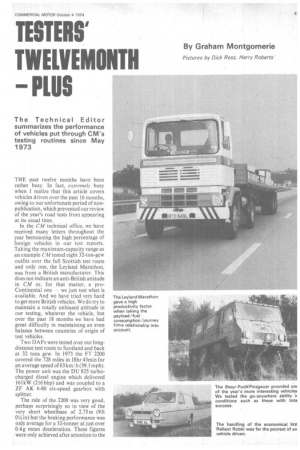
Page 36
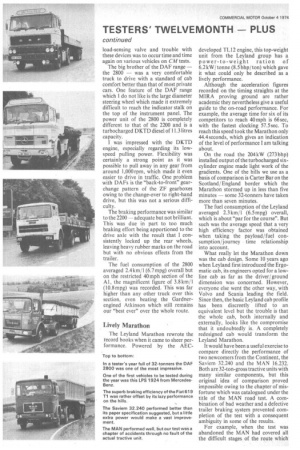
Page 37
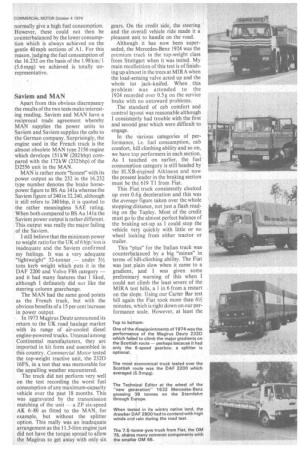
Page 38
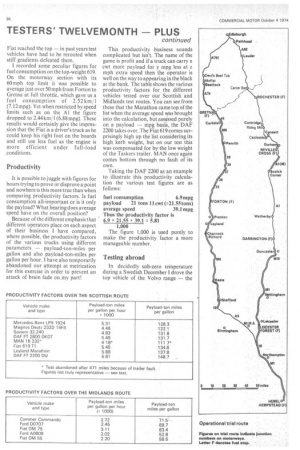
Page 39
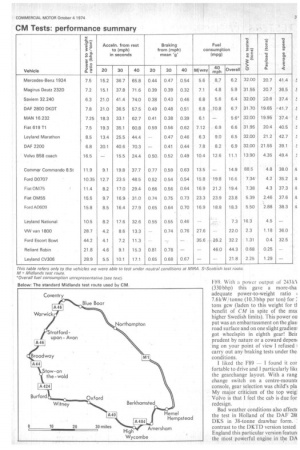
Page 40

Page 41
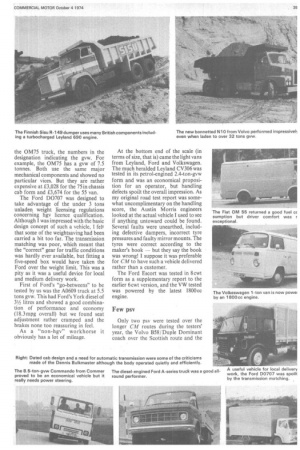
Page 43
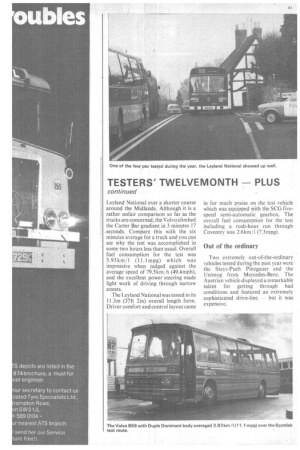
If you've noticed an error in this article please click here to report it so we can fix it.
By Graham Montgomerie
THE past twelve months have been rather busy. In fact, extremely busy when I realize that this article covers vehicles driven over the past 16 months, owing to our unfortunate period of nonpublication, which prevented our review of the year's road tests from appearing at its usual time.
In the CM technical office, we have received many letters throughout the year bemoaning the high percentage of foreign vehicles in our test reports. Taking the maximum-capacity range as an example CM tested eight 32-ton-gcw outfits over the full Scottish test route and only one, the Leyland Marathon, was from a British manufacturer. This does not indicate an anti-British attitude in CM or, for that matter, a pro Continental one we just test what is available. And we have tried very hard to get more British vehicles. We do try to maintain a totally unbiased attitude in our testing, whatever the vehicle, but over the past 18 months we have had great difficulty in maintaining an even balance between countries of origin of test vehicles.
Two DAFs were tested over our longdistance, test route to Scotland and back at 32 tons gcw. In 1973 the FT 2200 covered the 728 miles in 18hr 43min for an average speed of 63 km/ h (39.1 mph). The power unit was the DU 825 turbocharged diesel engine which delivered 161kW (216 bhp) and was coupled to a ZF AK 6-80 six-speed gearbox with splitter.
The ride of the 2200 was very good, perhaps surprisingly so in view of the very short wheelbase of 2.75m (9 ft 0¼ in) but the braking performance was only average for a 32-tonner at just over 0.4g mean deceleration. These figures were only achieved after attention to the load-sensing valve and trouble with these devices was to occur time and time again on various vehicles on CM tests.
The big brother of the DAF range — the 2800 — was a very comfortable truck to drive with a standard of cab comfort better than that of most private cars. One feature of the DAF range which I do not like is the large diameter steering wheel which made it extremely difficult to reach the indicator stalk on the top of the instrument panel. The power unit of the 2800 is completely different to that of the 2200 and is a turbocharged DKTD diesel of 11.3 litres capacity.
I was impressed with the DKTD engine, especially regarding its lowspeed pulling power. Flexibility was certainly a strong point as it was possible to pull away in any gear from around 1,000 rpm, which made it even easier to drive in traffic. One problem with DAFs is the "hack-to-front" gearchange pattern of the ZF gearboxes owing to the change-over to right-hand drive, but this was not a serious difficulty.
The braking performance was similar to the 2200 -adequate but not brilliant. This was due in part to too much braking effort being apportioned to the drive axle with the result that I consistently locked up the rear wheels, leaving heavy rubber marks on the road but with no obvious effects from the trailer.
The fuel consumption of the 2800 averaged 2.4km/1 (6.7 mpg) overall but on the restricted 40mph section of the Al, the magnificent figure of 3.8 km/1 (10,8 mpg) was recorded. This was far higher than any other truck over this section, even beating the Gardnerengined Atkinson which still remains our "best ever" over the whole route.
Lively Marathon
The Leyland Marathon rewrote the record books when it came to sheer performance. Powered by the AEC developed TLI2 engine, this top-weight unit from the Leyland group has a power-to-weight ration of 6.2 kW / tonne (8.5 bhp / ton) which gave it what could only be described as a lively performance.
Although the acceleration figures recorded on the timing straights at the MIRA proving ground are rather academic they nevertheless give a useful guide to the on-road performance. For example, the average time for six of its competitors to reach 40 mph is 66 see, with the fastest clocking 57.5sec. To reach this speed took the Marathon only 44.4 seconds, which gives an indication of the level of performance I am talking about.
On the road the 204 kW (273 bhp) installed output of the turbocharged sixcylinder engine made light work of the gradients. One of the hills we use as a basis of comparison is Carter Bar on the Scotland/ England border which the Marathon stormed up in less than five minutes — some 32-tonners have taken more than seven minutes.
The fuel consumption of the Leyland averaged 2.3 km/1 (6.5mpg) overall, which is about "par for the course". But such was the average speed that a very high efficiency factor was obtained when taking the payload/fuel consumption/ journey time relationship into account.
What really let the Marathon down was the cab design, Some 10 years ago when Leyland first introduced the Ergomatic cab, its engineers opted for a towline cab as far as the driver /ground dimension was concerned. However, everyone else went the other way, with Volvo and Scania leading the field. Since then, the basic Leyland cab profile has been discreetly lifted to an equivalent level but the trouble is that the whole cab, both internally and externally, looks like the compromise that it undoubtedly is. A completely redesigned cab would transform the Leyland Marathon.
It would have been a useful exercise to compare directly the performance of two newcomers from the Continent, the Saviem 32.240 and the MAN 16.232. Both are 32-ton-gross tractive units with many similar components, but this original idea of comparison proved impossible owing to the chapter of misfortune which was catalogued under the title of the MAN road. test. A combination of bad weather and a defective trailer braking system prevented completion of the test with a consequent ambiguity in some of the results.
For example, when the test was abandoned the MAN had covered all the difficult stages of the route which normally give a high fuel consumption. However, these could not then be counterbalanced by the lower consumption which is always achieved on the gentle 40 mph sections of Al. For this reason, judging the fuel consumption of the 16.232 on the basis of the 1.98 km/ 1 (5.6 mpg) we achieved is totally unrepresentative.
Saviem and MAN
Apart from this obvious discrepancy the results of the two tests make interesting reading. Saviem and MAN have a reciprocal trade agreement whereby MAN supplies the power units to Saviem and Saviem supplies the cabs to the German company. Surprisingly, the engine used in the French truck is the almost obsolete MAN type 2156 engine which develops 151 kW (202 bhp) compared with the 172 kW (232 bhp) of the D2556 unit in the MAN.
MAN is rather more "honest" with its power output as the 232 in the 16.232 type number denotes the brake horsepower figure to BS Au 141a whereas the Saviem figure of 240 in 32.240, although it still refers to 240 bhp, it is quoted to the rather meaningless SAE rating. When both compared to BS Au 14 la the Saviem power output is rather different. This output was really the major failing of the Saviem.
I still believe that the minimum power to weight ratio for the UK of 6 bjp/ ton is inadequate and the Saviem confirmed my feelings. It was a very adequate "lightweight" 32-tonner — under 51/2 tons kerb weight which puts it in the DAF 2200 and Volvo F86 category — and it had many features that I liked, although I definately did not like the steering column gearchange.
The MAN had the same good points as the French truck, but with the obvious benefits of a 15 per cent increase in power output.
In 1973 Magirus Deutz announced its return to the UK road haulage market with its range of air-cooled diesel engine-powered trucks. Unusual among Continental manufacturers, they are imported in kit form and assembled in this country. Commercial Motor tested the top-weight tractive unit, the 232D 16FS, in a test that was memorable for the appalling weather encountered.
The truck did not perform very well on the test recording the worst fuel consumption of any maximum-capacity vehicle over the past 18 months. This was aggravated by the transmission matching of the unit — a ZF six-speed AK 6-80 as fitted to the MAN, for example, but without the splitter option. This really was an inadequate arrangement as the 11.3-litre engine just did not have the torque spread to allow the Magirus to get away with only six gears. On the credit side, the steering and the overall vehicle ride made it a pleasant unit to handle on the road.
Although it has now been superseded, the Mercedes-Benz 1924 was the premium truck in the top-weight class from Stuttgart when it was tested. My main recollection of this test is of finishing up almost in the trees at MIRA when the load-sensing valve acted up and the whole lot jack-knifed. When , this problem was attended to the 1924 recorded over 0.5g on the service brake with no untoward problems.
The standard of cab comfort and control layout was reasonable although I consistently had trouble with the first and second gear which were difficult to engage.
In the various categories of performance, i.e. fuel consumption, cab comfort, hill climbing ability and so on, we have top performers in each section.
As I touched on earlier, the fuel consumption category is still headed by the 8LXB-engined Atkinson and now the present leader in the braking section must be the, 619 Ti from Fiat.
This Fiat truck consistently clocked up over 0.6g deceleration and this was the average figure taken over the whole stopping distance, not just a flash reading on the Tapley. Most of the credit must go to the almost perfect balance of the braking set-up as I could stop the vehicle very quickly with little or no wheel locking from either tractor or trailer.
This "plus" for the Italian track was counterbalanced by a big "minus" in terms of hill-climbing ability. The Fiat was just plain slow when it came to a gradient, and I was given some preliminaq warning of this when I could not climb the least severe of the MIRA test hills, a 1 in 6 from a restart on the slope. Using our Carter Bar test hill again the Fiat took more than 61/2 minutes, which is right down on our performance scale. However, at least the Fiat reached the top in past years test vehicles have had to be rerouted when stiff gradients defeated them.
I recorded some peculiar figures for fuel consumption on the top-weight 619. On the motorway section with its 60 mph top limit it was possible to average just over 50 mph from Forton to Gretna at full throttle, which gave us a fuel consumption of 2.52 km/1 (7.12 mpg). Yet when restricted by speed limits such as on the Al the figure dropped to 2.44 km/1 (6.88 mpg). These results would certainly give the impression that the Fiat is a driver's truck as he could keep his right foot on the boards and still use less fuel as the engine is more efficient under full-load conditions.
Productivity
It is possible to juggle with figures for hours trying to prove or disprove a point and nowhere is this more true than when comparing productivity factors. Is fuel consumption all-important or is it only the payload? What bearing does average speed have on the overall position?
Because of the different emphasis that different operators place on each aspect of their business I have compared, where possible, the productivity factors of the various trucks using different parameters payload-ton-miles per gallon and also payload-ton-miles per gallon per hour. I have also temporarily abandoned our attempt at metrication for this exercise in order to prevent an attack of brain fade on .my part! This productivity business sounds complicated but isn't. The name of the game is profit and if a truck can carry x cwt more payload for y mpg less at z mph extra speed then the operator is well on the way to appearing in the black at the bank. The table shows the various productivity factors for the different vehicles tested over our Scottish and Midlands test routes. You can see from these that the Marathon came top of the list when the average speed was brought into the calculation, but assessed purely on a payload mpg basth, the DAF 2200 takes over. The Fiat 619 comes surprisingly high up the list considering its high kerb weight, but on our test this was compensated for by the low weight of the Taskers trailer. MAN once again comes bottom through no fault of its own.
Taking the DAF 2200 as an example to illustrate this productivity calculation the various test figures are as follows:
fuel consumption 6.9 mpg payload 21 tons 11 cwt (=21.55 tons) average speed 39.1 mpg Thus the productivity factor is
6.9 x 21.55 x 39.1 = 5.81
1,000 The figure 1,000 is used purely to make the productivity factor a more manageable number.
Testing abroad
In decidedly sub-zero temperature during a Swedish December I drove the top vehicle of the Volvo range the F89. With' a power output a 243k\ (330 bhp) this gave a more-tha adequate power-to-weight ratio I 7.6kW/ tonne (10.3 bhp per ton) for tons gcw (laden to this weight for ti benefit of CM in spite of the mu( higher Swedish limits). This power ou put was an embarrassment on the glas; road surface and on one slight gradieni got wheelspin in eighth gear! Beir prudent by nature or a coward depen ing on your point of view I refused 1 carry out any braking tests under the, conditions.
I liked the F89 1 found it cor fortable to drive and I particularly likr the gearchange layout. With a rang change switch on a centre-mount( console, gear selection was child's pla My major criticism of the top weig] Volvo is that I feel the cab is due for redesign.
Bad weather conditions also affect( the test in Holland of the DAF 28( DKS in 38-tonne drawbar form, contrast to the DKTD version tested England this particular version featur( the most powerful engine in the DA range, the 238 kW (320 bhp) DKS. The drawbar outfit handled well and in spite of the 18.3m (60 ft) overall length could be taken through narrow streets with little difficulty. Rain, snow ice and fog upset the original plan of driving over a near-mountainous route near the border.
The Sternfahrt or "Stardrive" organized by Daimler-Benz to announce its new generation of trucks was an interesting exercise. Starting from "star points" at Utrecht, Strasbourg, Salzburg, Copenhagen and Ostend five drawbar outfits driven by ;elected journalists converged on Bruchsal. I started from Ostend and found fault with the steering and braking system, on the journey across Europe. But when I drove a later model in England recently these defects had been eradicated.
Two on/off highway vehicles came our way during the past year, the physically similar VolVo NIO and the Sisu R-149. The "sighting poles" on the wings of both vehicles were useful for close manoeuvring as forward visibility was not brilliant.
Both trucks have a similar specification for the major components; for example, a turbocharged six-cylinder diesel of around 230 bhp is common to both, a Leyland 690 being used in the Finnish truck while Volvo uses one of its own designs. When I drove the NIO it was at a gvw of over 32 tons and I managed to reach fifth gear on the fairly steep ramp out of the quarry where the brief test took place.
It has been said that variety is the spice of life and there can be no greater variety than the difference between a Volvo NIO and a three-wheeled Reliant Robin. This diminutive vehicle gave me some of my more frightening experiences during the year because of its appalling handling. The fuel consumption averaged over 40 mpg and it was very nippy in stop/ start traffic work, but this was overruled by its performance on bends and especially around traffic islands.
Middleweight range
Although our tests this year have been mainly of maximum weight vehicles, we have not ignored the medium ranges entirely. The Commer Commando was tested around the Midlands route in 8.5 tons gvw form and it averaged 5.3 km/1 (14.9 mpg) overall for a payload of 4.8 tons. The Commer in general performed very well, but it really does need power steering.
Two small Fiats were put through their paces in 1974, the 0N55 van and the 0M75 truck, the numbers in the designation indicating the gvw. For example, the 0M75 has a gvw of 7.5 tonnes. Both use the same major mechanical components and showed no particular vices. But they are rather expensive at £3,028 for the 75 in chassis cab form and £3,674 for the 55 van.
The Ford D0707 was designed to take advantage of the under 3 tons unladen weight licensing regulations concerning hgv licence qualification. Although I was impressed with the basic design concept of such a vehicle, I felt that some of the weightsaving had been carried a bit too far. The transmission matching was poor, which meant that the "correct" gear for traffic conditions was hardly ever available, but fitting a five-speed box would have taken the Ford over the weight limit. This was a pity as it was a useful device for local and medium delivery work.
First of Ford's "go-betweens" to be tested by us was the A0609 truck at 5.5 tons gvw. This had Ford's York diesel of 31/2 litres and showed a good combination of performance and economy (18.3 mpg overall) but we found seat adjustment rather cramped and the brakes none too reassuring in feel.
As a "non-hgv" workhorse it obviously has a lot of mileage. At the bottom end of the scale (in terrns of size, that is) came the light vans from Leyland, Ford and Volkswagen. The much heralded Leyland CV306 was tested in its petrol-engined 2.4-ton-gvw form and was an economical proposition for an operator, but handling defects spoilt the overall impression. As my original road test report was somewhat uncomplimentary on the handling score, the Austin Morris engineers looked at the actual vehicle I used to see if anything untoward could be found. Several faults were unearthed, including defective dampers, incorrect tyre pressures and faulty mirror mounts. The tyres were correct according to the maker's book — but they say the book was wrong! I suppose it was preferable for CM to have such a vehicle delivered rather than a customer.
The Ford Escort was tested in 8 cwt form as a supplementary report to the earlier 6cwt version, and the VW tested was powered by the latest 1800ce engine.
Few psv
Only two psv were tested over the longer CM routes during the testers' year, the Volvo B58/ Duple Dominant coach over the Scottish route and the
Leyland National over a shorter course around the Midlands. Although it is a rather unfair comparison so far as the trucks are concerned, the Volvo climbed the Carter Bar gradient in 3 minutes 17 seconds, Compare this with the six minutes average for a truck and you can see why the test was accomplished in some two hours less than usual. Overall fuel consumption for the test was 3.93km/1 (11,1mpg) which was impressive when judged against the average speed of 79.5k m/ h (49.4mph), and the excellent power steering made light work of driving through narrow streets.
The Leyland National was tested in its 11.3m (37ft 2in) overall length form. Driver comfort and control layout came in for much praise on the test vehicle which was equipped with the SCG fivespeed semi-automatic gearbox. The overall fuel consumption for the test including a rush-hour run through Coventry was 2.6km/ l (7.3mpg).
Out of the ordinary
Two extremely out-of-the-ordinary vehicles tested during the past year were the Steyr-Puch Pinzgauer and the Unimog from Mercedes-Benz. The Austrian vehicle displayed a remarkable talent for getting through had conditions and featured an extremely sophisticated drive-line — but it was expensive.












































































































